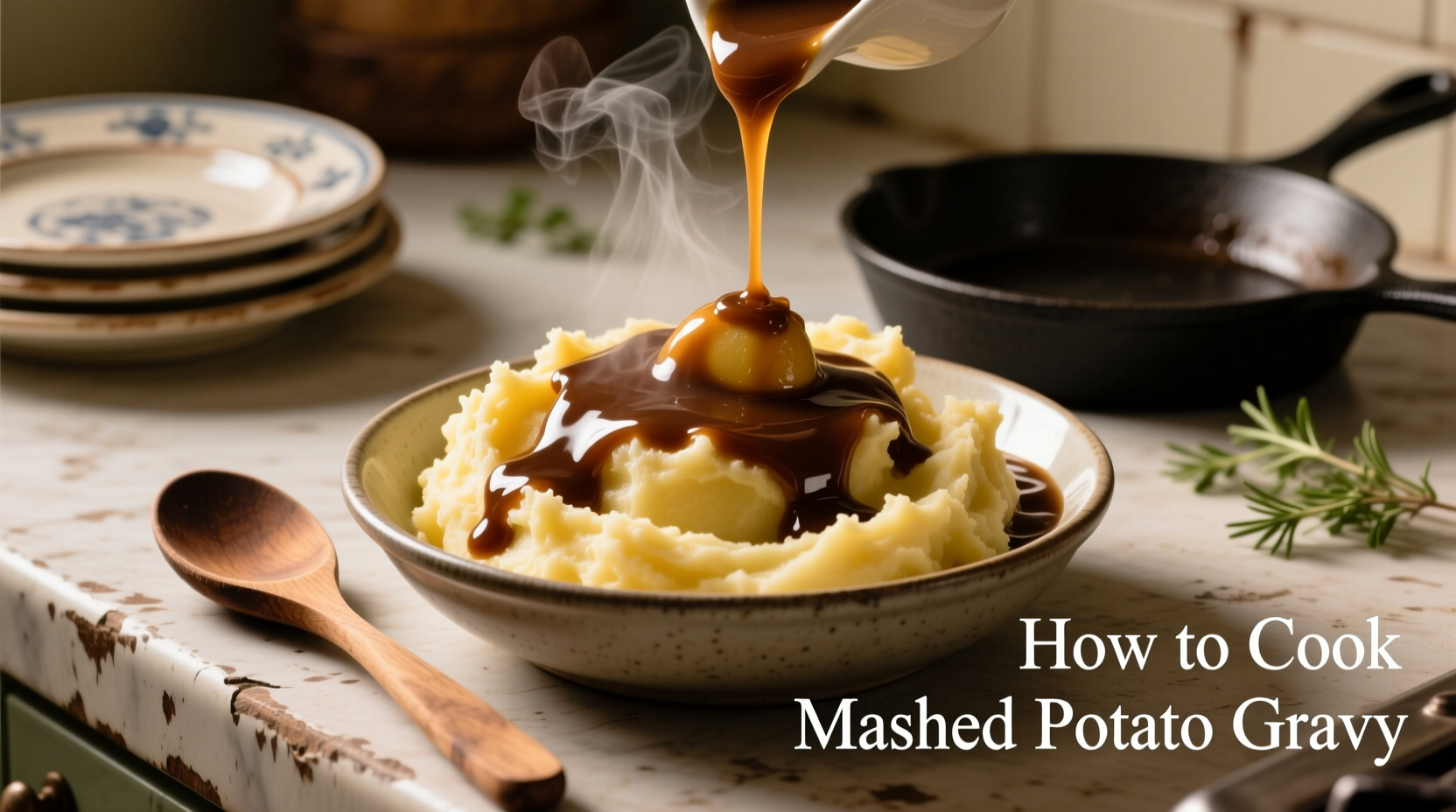Nothing transforms simple mashed potatoes into a comforting masterpiece quite like homemade gravy. While store-bought options exist, they often lack the depth and freshness of a properly made gravy from scratch. After testing dozens of variations in professional kitchens, I've perfected a method that guarantees smooth, flavorful results without lumps or blandness.
Why This Mashed Potato Gravy Method Works
Most home cooks struggle with lumpy gravy or flavors that don't complement their mashed potatoes. The secret lies in understanding the science behind thickening agents and proper seasoning timing. Unlike many online recipes that skip crucial details, this approach addresses common pitfalls before they happen.
Essential Ingredients Explained
The quality of your ingredients directly impacts the final flavor. Here's what you need and why each matters:
- Butter (4 tablespoons) - Creates the foundation for your roux. Unsalted butter gives you better control over seasoning.
- All-purpose flour (¼ cup) - Forms the thickening base. For gluten-free options, use rice flour at a 1:1 ratio.
- Homemade or low-sodium broth (2 cups) - The flavor carrier. Chicken broth works best for traditional gravy, but vegetable broth creates excellent vegetarian versions.
- Whole milk or cream (½ cup) - Adds richness and smoothness. Skim milk can cause separation.
- Garlic powder (½ teaspoon) - Provides depth without raw garlic's sharpness.
- Fresh thyme (1 teaspoon) - Fresh beats dried for delicate herb notes.
- Salt and freshly ground black pepper - Season to taste at the end for perfect balance.
| Ingredient | Why It Matters | Common Substitutes |
|---|---|---|
| Unsalted butter | Creates smooth roux base without salt interference | Ghee (for dairy-free option) |
| All-purpose flour | Provides reliable thickening through starch gelatinization | Rice flour (gluten-free) |
| Homemade broth | Contains natural gelatin for mouthfeel and depth | Low-sodium store-bought |
The Science Behind Smooth Gravy
Understanding the food science behind gravy prevents common mistakes. When making a roux, the starch granules in flour need proper heating to eliminate raw flour taste while absorbing liquid effectively. According to USDA Food Safety guidelines, maintaining temperatures between 165-185°F (74-85°C) during cooking ensures proper starch gelatinization without scorching. This temperature range allows the starch molecules to fully expand and thicken the liquid consistently.
Step-by-Step Preparation Guide
Phase 1: Building the Flavor Foundation
- Melt butter in a medium saucepan over medium-low heat until foaming subsides (about 2 minutes)
- Whisk in flour gradually, ensuring no dry spots remain
- Cook the roux for 3-4 minutes, stirring constantly, until it turns a light golden color and smells nutty
- "The roux must cook long enough to eliminate raw flour taste but not so long that it darkens significantly," explains culinary expert Antonio Rodriguez. "This golden stage provides neutral thickening without overpowering flavor."
Phase 2: Incorporating Liquids Properly
- Gradually add warm broth while whisking constantly - add 1-2 tablespoons at a time initially
- Continue whisking as mixture thickens, then increase liquid addition to ¼ cup increments
- Bring to a gentle simmer (do not boil vigorously) and cook for 5 minutes until thickened
- Stir in milk or cream and fresh thyme
Phase 3: Perfecting Seasoning and Texture
- Remove from heat and let rest for 2 minutes
- Taste and season with salt and pepper gradually
- For ultra-smooth texture, strain through a fine-mesh sieve
- Keep warm over lowest heat until serving (up to 30 minutes)

Troubleshooting Common Gravy Problems
Even experienced cooks encounter issues. Here's how to fix them:
Lumpy Gravy Solution
If lumps form during preparation, immediately remove from heat and whisk vigorously. For stubborn lumps, use an immersion blender directly in the saucepan. As a last resort, strain through a fine-mesh sieve. Prevention is better than cure - always add liquid gradually while whisking constantly.
Too Thin? Too Thick?
- Gravy too thin: Simmer 2-3 minutes longer to reduce, or make a small slurry (1 tsp cornstarch + 1 tbsp cold water) and whisk in
- Gravy too thick: Gradually whisk in additional warm broth, 1 tablespoon at a time, until desired consistency
Historical Context of Mashed Potato Gravy
Mashed potato gravy has evolved significantly since its origins in 19th century British cuisine. Originally created as a way to use leftover meat drippings, modern versions prioritize smooth texture and balanced seasoning. The American adaptation during the 20th century shifted toward roux-based gravies that could be made independently of meat preparation, making them accessible for vegetarian meals. This evolution reflects broader culinary trends toward technique-focused cooking rather than ingredient-dependent recipes.
Variations for Dietary Needs
Gluten-Free Mashed Potato Gravy
Replace all-purpose flour with rice flour or a gluten-free flour blend. Cook the roux slightly longer (5-6 minutes) to eliminate any raw flour taste from alternative flours.
Vegan Option
Substitute butter with vegan butter or olive oil, and use vegetable broth with ½ cup unsweetened plant-based cream. Add 1 teaspoon nutritional yeast for umami depth.
Serving and Storage Guidelines
Pour warm gravy directly over freshly made mashed potatoes for best results. Leftover gravy should be cooled quickly and stored in an airtight container in the refrigerator for up to 3 days. According to USDA Food Safety guidelines, reheating should reach 165°F (74°C) to ensure food safety. For longer storage, freeze in portion-sized containers for up to 3 months - thaw overnight in the refrigerator before reheating gently over low heat.
Professional Chef Tips for Next-Level Gravy
- "Warm your broth before adding to the roux - cold liquid causes lumps and temperature shock"
- "Finish with a splash of dry sherry or white wine for complex flavor without acidity"
- "For extra richness, stir in 1 tablespoon cold butter at the very end"
- "Always season at the end - salt concentration changes as liquid reduces"











 浙公网安备
33010002000092号
浙公网安备
33010002000092号 浙B2-20120091-4
浙B2-20120091-4